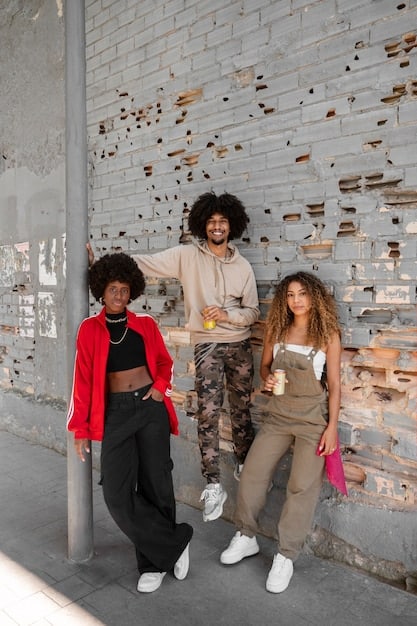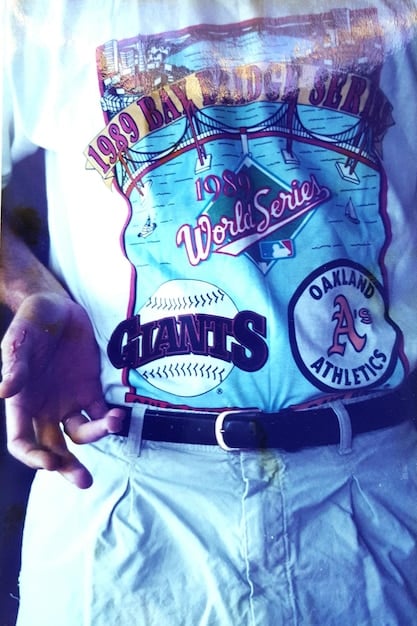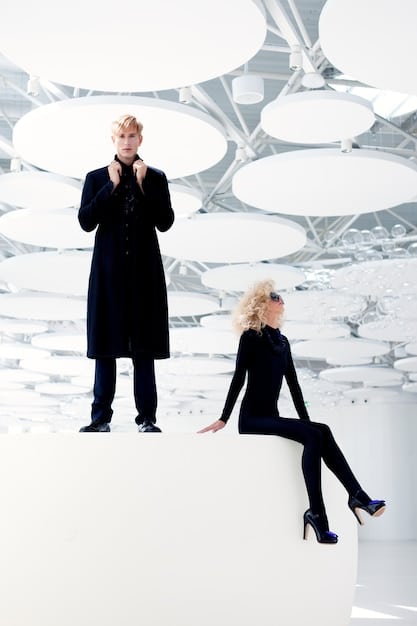The Evolution of Streetwear: From Underground Culture to Global Fashion

The Evolution of Streetwear traces its roots from niche subcultures like skateboarding and hip-hop to its current status as a dominant force in mainstream fashion, influencing high-end designers and everyday wardrobes alike.
The Evolution of Streetwear: From Subculture to Mainstream Fashion is a compelling story of how counter-cultural movements organically shaped the global fashion landscape we know today. From its rebellious roots to its luxury collaborations, streetwear’s journey is one of constant reinvention. Let’s explore this influential transformation together.
The Birth of Streetwear: A Cultural Melting Pot
Streetwear emerged from a confluence of subcultures, each contributing its distinct flavor. Understanding its genesis is crucial to appreciating its current form.
It wasn’t designed in boardrooms; it organically sprung from various youth cultures and lifestyle movements.
Skateboarding’s Influence
Skateboarding culture, particularly in Southern California, played a seminal role in shaping streetwear. The need for durable and comfortable clothing to withstand the rigors of skating led to the adoption of specific styles.
Brands like Vans and Stüssy, initially catering to skaters, became synonymous with this emerging aesthetic. Their practicality and understated cool resonated far beyond the skate park.
Hip-Hop’s Impact
Simultaneously, hip-hop culture in New York City was also leaving its mark. Rappers and DJs embraced brands like Adidas, Puma, and Kangol, transforming them into status symbols and core elements of hip-hop fashion.
The oversized silhouettes, bold logos, and athletic-inspired pieces of hip-hop attire became cornerstones of streetwear’s visual language.
- Skateboarding and Hip-Hop: The foundational influences.
- DIY Culture: Customization and individuality.
- Music Scenes: Punk, hardcore, and electronic music scenes also influenced streetwear through fashion and graphic design.
The fusion of these influences created a unique style, a departure from established fashion norms. Early streetwear brands like Stüssy, which started by selling screen-printed t-shirts to surfers and skaters, captured this spirit of independence.
Early Pioneers: Shaping the Aesthetic
Several brands and designers were instrumental in solidifying streetwear’s identity. They understood the culture and catered to its desire for authenticity and exclusivity.
These pioneers tapped into the community’s desire for self-expression, moving beyond mere clothing to become cultural arbiters.
Stüssy: The Original Streetwear Brand
Shawn Stussy’s surf-inspired designs resonated deeply with the Southern California skate and surf community, laying the foundation for the brands emergence.
Stüssy innovatively used DIY techniques and local distribution to create a sense of exclusivity and insider knowledge, crucial for fostering brand loyalty.
Supreme: Cultivating Exclusivity
Supreme, founded in 1994, took a different approach. By focusing on limited-edition releases and collaborations with artists and designers, the brand developed a cult following.
Supreme’s scarcity-driven model created hype and demand, turning its products into highly sought-after collectibles and status symbols in the streetwear scene.

These early brands fostered a sense of community, where clothing was not just about practicality, but also about belonging and self-expression.
The Internet’s Impact: Streetwear Goes Global
The internet revolutionized streetwear, transforming it from a localized phenomenon into a global movement. The advent of online forums, blogs, and e-commerce platforms created unprecedented opportunities for brands and consumers alike.
The rise of digital platforms allowed streetwear to quickly disseminate its culture and merchandise worldwide breaking geographical barriers.
Online Communities and Forums
Online communities like NikeTalk and Superfuture provided spaces for enthusiasts to connect, share information, and buy/sell exclusive items. These platforms democratized access to streetwear, allowing smaller brands to gain exposure.
These digital communities fueled discussions, trends awareness, and the overall growth of the culture by creating an active space for enthusiasts.
E-commerce and Direct-to-Consumer Brands
E-commerce platforms enabled independent brands to reach global audiences without the need for traditional retail channels. This lowered barriers to entry and fostered innovation.
The direct-to-consumer model empowers streetwear brands to maintain control over the market, ensuring greater creative freedom and brand identity.
These factors facilitated access to streetwear both on a brand and consumer level causing it to become significantly more widespread.
High Fashion Embraces Streetwear
Initially seen as a counter-cultural movement, streetwear has gradually infiltrated high fashion, leading to collaborations that blur the lines between luxury and street style. This fusion reflects a shift in attitudes, driven by the increasing cultural influence of younger generations.
This fusion has democratized high fashion, making it more accessible and reflective of contemporary tastes.
Luxury Collaborations
Luxury brands like Louis Vuitton, Dior, and Gucci have collaborated with streetwear icons like Supreme, KAWS, and A Bathing Ape, challenging conventional notions of luxury and exclusivity.
These collaborations often result in limited-edition collections that generate immense hype and demand, further blurring the lines between high fashion and street style. Such partnerships demonstrate a growing appreciation of streetwear’s cultural capital.
The Rise of Streetwear Designers in High Fashion
Designers with a streetwear background are ascending to prominent positions in luxury houses. Virgil Abloh’s appointment as artistic director of Louis Vuitton menswear marked a watershed moment, symbolizing the mainstream recognition of streetwear’s influence.
The appointments highlight a cultural shift towards greater authenticity and creativity, reflecting the evolving tastes of consumers. Streetwear influence on high-fashion continues as creative directors contribute innovative approaches.

Streetwear has not only captured the attention of high-end brands but has also redefined its own position. This collaboration ensures a continued relevance and influence for both streetwear and high fashion.
The Evolution of Streetwear Sub-Styles
As streetwear has evolved, different sub-styles have emerged, each reflecting unique influences and aesthetic qualities. Understanding these nuances provides a deeper appreciation for the complexity and diversity of the culture.
These sub-styles cater to different tastes and consumer preferences, reflecting various aesthetics from minimalist to avant-garde.
Techwear
Techwear combines functionality with futuristic aesthetics, utilizing innovative materials and designs to create practical and stylish garments. Brands like Acronym and Stone Island are at the forefront of this movement.
Garments often feature waterproof fabrics, modular components, and enhanced durability, appealing to those prioritizing performance and practicality. Techwear represents a blend of innovation and fashion.
Luxury Streetwear
Luxury streetwear elevates classic streetwear pieces with high-end materials and craftsmanship. This style often incorporates designer logos and exclusive collaborations to command premium prices.
Brands like Off-White and Balenciaga have capitalized on this trend, creating highly coveted items that blend luxury with casual wear. This trend has allowed streetwear to reach a new customer base with refined tastes.
- Skate Inspired: Relaxed fits, durable materials, graphic-heavy pieces.
- Workwear: Durable fabrics, functional designs, utilitarian aesthetics.
- Gorpcore: Outdoor gear adapted for urban environments.
Streetwear has shown the ability to be flexible and ever-changing demonstrating its long-term cultural relevance. The evolution of streetwear’s sub-styles has made the market more receptive to innovation.
Streetwear’s Future: Sustainability and Inclusivity
As streetwear matures, themes of sustainability and inclusivity are gaining prominence, reflecting broader societal concerns. Consumers are increasingly demanding ethical and environmentally responsible practices from brands.
These progressive values are reshaping the industry, fostering a more conscious and equitable approach to fashion.
Sustainable Practices
Streetwear brands are adopting sustainable practices, such as using recycled materials, reducing waste, and ensuring fair labor conditions. This shift reflects a growing awareness of the environmental and social impact of the fashion industry.
This movement towards sustainability aligns with the broader global effort to reduce carbon footprint. Consumers are now more vigilant of brands commitment to sustainability.
Inclusivity and Diversity
Streetwear brands are emphasizing inclusivity by featuring diverse models, offering extended size-ranges, and collaborating with marginalized communities. This reflects a commitment to representing a wider range of body types, ethnicities, and gender identities.
Embracing diversity enables streetwear to connect with a broader audience by creating an inclusive community for all. Streetwear champions inclusivity while dismantling conventional societal expectations.
| Key Point | Brief Description |
|---|---|
| 🛹 Origin | Emerged from skateboarding and hip-hop cultures. |
| 🌐 Globalization | The Internet expanded streetwear’s reach worldwide. |
| 🤝 Collaborations | Luxury brands have combined with streetwear, changing fashion. |
| 🌱 Future | Focus on sustainability and diversity grows. |
FAQ
▼
Streetwear is most notably influenced by skateboarding and hip-hop cultures, each providing distinct elements to the aesthetic from practicality to bold expression.
▼
The internet enabled the globalization of streetwear through online communities, e-commerce platforms, and social media, broadening the reach of brands and trends.
▼
Techwear is a streetwear sub-style focused on functionality, utilizing advanced materials and designs to create garments suitable for urban and outdoor environments.
▼
Luxury brands collaborate with streetwear labels to tap into youth culture, revitalize their image, and create exclusive products that generate immense hype and demand among consumers.
▼
Streetwear brands increasingly adopt eco-friendly methods for production, such as the use of recycled materials, waste reduction, and ethical labor practices, aiming for an eco-conscious footprint.
Conclusion
Whether it’s high fashion brands taking inspiration from streetwear, or brands being conscious of sustainability, the evolution of streetwear has no end. Ultimately, the journey from underground subculture to mainstream prominence underscores streetwear’s enduring creativity and community focus.





